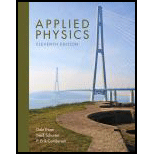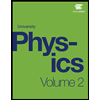
Applied Physics (11th Edition)
11th Edition
ISBN: 9780134159386
Author: Dale Ewen, Neill Schurter, Erik Gundersen
Publisher: PEARSON
expand_more
expand_more
format_list_bulleted
Textbook Question
Chapter 15, Problem 4AC
A 0.0300-m3 steel tank containing helium is stored at 20.0ºC under a pressure of 22.5 × 103 kPa. (a) If the helium is released into a 20.0ºC, 101-kPa atmosphere, how much volume will the helium occupy? (b) How much volume will the released helium occupy if released into a -28.5ºC, 285-Pa stratosphere?
Expert Solution & Answer
Want to see the full answer?
Check out a sample textbook solution
Students have asked these similar questions
What increase in altitude is necessary in the stratosphere to halve the pressure?
Assume a constant temperature of -56.9°c and the gas constant, R=287J/kg/K
Assuming air as the perfect gas, find the density of air at an altitude of 10000 feet at which the pressure is 50225 Pa, assuming the International Standard Atmosphere (ISA) weather conditions at sea level. (Under standard atmospheric conditions, the air pressure is 101325 Pa, its density is 1,225 kg / m3, its temperature is 15 0C. In every 1000 feet in the troposphere, the temperature drops by 2 K.)
What was the precise temperature at the bottom of Lake Superior at 12:01 am on October 31, 2000?
Chapter 15 Solutions
Applied Physics (11th Edition)
Ch. 15.1 - Change 15C to K.Ch. 15.1 - Prob. 2PCh. 15.1 - Prob. 3PCh. 15.1 - Change 235 K to C.Ch. 15.1 - Prob. 5PCh. 15.1 - Prob. 6PCh. 15.1 - Prob. 7PCh. 15.1 - Change 375R to F.Ch. 15.1 - T=315 K, V=225 cm3, T=275 K, find V.Ch. 15.1 - T=615R, V=60.3 in3, T=455R, find V.
Ch. 15.1 - V=200 ft3, T=95F, V=250 ft3, find T.Ch. 15.1 - Prob. 12PCh. 15.1 - Some gas occupies a volume of 325 m3 at 41 C. What...Ch. 15.1 - Some oxygen occupies 275 in3 at 35C. Find its...Ch. 15.1 - Some methane occupies 1575 L at 45C. Find its...Ch. 15.1 - Some helium occupies 1200ft3 at 70F. At what...Ch. 15.1 - Some nitrogen occupies 14,300 cm3 at 25.6C. What...Ch. 15.1 - Some propane occupies 1270 cm2 at 18.0C. What is...Ch. 15.1 - Some carbon dioxide occupies 34.5 L at 49.0C. Find...Ch. 15.1 - Some oxygen occupies 28.7 ft3 at 11.0F. Find its...Ch. 15.1 - A balloon contains 26.0 L of hydrogen at 40.0F....Ch. 15.1 - Using Charles's law, determine the effect (a) on...Ch. 15.1 - If 38.0 L of hydrogen is heated to 110C and...Ch. 15.1 - Prob. 24PCh. 15.1 - A hot air balloon contains 147 m3 of air at 19.0C....Ch. 15.1 - A tank with 139 L of propane is cooled from 91.0C...Ch. 15.1 - A 2000 L fuel tank filled with propane at 21C is...Ch. 15.1 - A propane nurse tank is left on a job site...Ch. 15.1 - A propane tank now containing 250L of propane was...Ch. 15.1 - A tank with 500 L of propane is heated from 17.0C...Ch. 15.2 - V'=315 cm3, P=101 kPa, P'=85.0 kPa; find V.Ch. 15.2 - V=450L, V'=700L, P=750 kPa; find P'.Ch. 15.2 - V=76.0 m3, V'=139 m3, P'=41.0 kPa; find P.Ch. 15.2 - V=439 in3, P'=38.7 psi, P=47.1 psi; find V'.Ch. 15.2 - D=1.80 kg/m3, P=108 kPa, P'=125 kPa; find D'.Ch. 15.2 - Prob. 6PCh. 15.2 - P=51.0 psi, P'=65.3 psi, D'=0.231 lb/ft3; find D.Ch. 15.2 - Some air at 22.5 psi occupies 1400 in3. What is...Ch. 15.2 - Prob. 9PCh. 15.2 - Prob. 10PCh. 15.2 - Prob. 11PCh. 15.2 - Some oxygen has a density of 1.75 kg/m3 at normal...Ch. 15.2 - Some methane at 500 kPa gauge pressure occupies...Ch. 15.2 - Prob. 14PCh. 15.2 - Some nitrogen at 80.0 psi gauge pressure occupies...Ch. 15.2 - Prob. 16PCh. 15.2 - Prob. 17PCh. 15.2 - Some propane occupies 2.30 m3 at a gauge pressure...Ch. 15.2 - A quantity of oxygen at a gauge pressure of 20.0...Ch. 15.2 - Some air occupies 4.5 m3 at a gauge pressure of 46...Ch. 15.2 - Some oxygen at 87.6 psi (absolute) occupies 75.0...Ch. 15.2 - A gas at 300 kPa (absolute) occupies 40.0 m3. Find...Ch. 15.2 - A volume of 58.0 L of hydrogen is heated from 33C...Ch. 15.2 - Prob. 24PCh. 15.2 - A 2.00-L plastic bottle contains air at a pressure...Ch. 15.2 - Prob. 26PCh. 15.2 - A mass of 1.31 kg of neon is in a 3.00-m3...Ch. 15.2 - The air density in a tractor tire is 1.40 kg/m3 at...Ch. 15.2 - An unknown gas is in a tank at 13.3 kPa. (a) If...Ch. 15.3 - Use Vp=VPto find each quantity. (All pressures are...Ch. 15.3 - Use Vp=VP to find each quantity. (All pressures...Ch. 15.3 - Use Vp=VPto find each quantity. (All pressures are...Ch. 15.3 - Use Vp=VPto find each quantity. (All pressures are...Ch. 15.3 - Use Vp=VP to find each quantity. (All pressures...Ch. 15.3 - We have 600 in3 of oxygen at1500 psi at 65F. What...Ch. 15.3 - We have 800m3 of natural gas at 235 kPa at 30C....Ch. 15.3 - We have 1400 L of nitrogen at 135 kPa at 54C. What...Ch. 15.3 - An acetylene welding tank has a pressure of 2000...Ch. 15.3 - What is the new pressure in Problem 9 if the...Ch. 15.3 - An ideal gas occupies a volume of 5.00 L at STP....Ch. 15.3 - An ideal gas occupies a volume of 5.00 L at STP....Ch. 15.3 - Some propane occupies 2.00 m3 at18.0C at an...Ch. 15.3 - A balloon with volume 3200 mL of xenon gas is at a...Ch. 15.3 - A 7 85-L helium-filled balloon experiences a...Ch. 15 - Prob. 1RQCh. 15 - Prob. 2RQCh. 15 - Prob. 3RQCh. 15 - Prob. 4RQCh. 15 - Prob. 5RQCh. 15 - Prob. 6RQCh. 15 - Prob. 7RQCh. 15 - Prob. 8RQCh. 15 - Prob. 9RQCh. 15 - What causes the tendency of the volume and...Ch. 15 - What causes the tendency of the temperature of a...Ch. 15 - What causes the tendency of the pressure of a gas...Ch. 15 - A gas occupies 13.5 ft3 at 35.8F. What will the...Ch. 15 - A gas occupies 3.45 m3 at 18.5 C. What will the...Ch. 15 - Some hydrogen occupies 115 ft3 at 54.5F. What is...Ch. 15 - Some carbon dioxide occupies 45.3 L at 38.5C. What...Ch. 15 - Some propane occupies 145 cm3 at 12.4 C. What is...Ch. 15 - Some air at 276 kPa occupies 32.4 m3. What is its...Ch. 15 - Some helium at 17.5 psi gauge pressure occupies...Ch. 15 - Prob. 8RPCh. 15 - We have 435 in3 of nitrogen at 1340 psi gauge...Ch. 15 - We have 755 m3 of carbon dioxide at 344 kPa at...Ch. 15 - A welding tank has a gauge pressure of 1950 psi at...Ch. 15 - An ideal gas occupies a volume of 4.50 L at STP....Ch. 15 - An ideal gas occupies a volume of 5.35 L at STP....Ch. 15 - A volume of 1120 L of helium at 4000 Pa is heated...Ch. 15 - In a 47-cm-tall cylinder of radius 7.0 cm,...Ch. 15 - Fran purchases a 1.85-ft3, helium-filled Mylar...Ch. 15 - An automobile tire is filled to an air pressure of...Ch. 15 - A 15.0-cm-long cylinder has a movable piston with...Ch. 15 - A 0.0300-m3 steel tank containing helium is stored...Ch. 15 - A lightweight weather-collecting sensor is...
Additional Science Textbook Solutions
Find more solutions based on key concepts
Choose the best answer to each of the following Explain your reasoning. 3.The modern organism that appeared to ...
The Cosmic Perspective Fundamentals (2nd Edition)
3. What is free-fall, and why does it make you weightless? Briefly describe why astronauts are weightless in th...
The Cosmic Perspective (8th Edition)
Parachutists whose chutes have failed to open have been known to survive if they land in deep snow. Assume that...
Physics for Scientists and Engineers with Modern Physics
Youre assessing the Engineered Material Arresting System (EMAS) at New Yorks JFK airport. The system consists o...
Essential University Physics (3rd Edition)
Two identical bubbles of gas form at the bottom of a lake, then rise to the surface. Because the pressure is mu...
An Introduction to Thermal Physics
Knowledge Booster
Learn more about
Need a deep-dive on the concept behind this application? Look no further. Learn more about this topic, physics and related others by exploring similar questions and additional content below.Similar questions
- When is the relative humidity 100%? It may be raining, but a sheltered psychrometer doesnt read 100%. Why?arrow_forwardCan the temperature ever rise with altitude in the real atmosphere?Wouldn’t this cause the air pressure to increaseupward? Explain the physics of this situation.arrow_forwardA student has basalt at 23 degrees Celsius and wants to know what the new temperature would be if they added 5.00Kj of heat to 115.0g of basalt?arrow_forward
- Assume that the composition of the earth’s atmosphere is constant below an altitude of 100 km and according to Barometric equation, the pressure decreases with altitude and the atmosphere has a uniform temperature of 25°C. Calculate the barometric pressure in Pa at Mount Ağrı, for which h = 5137m (g = 9.80 m/s2). Assume that 80% of the air is nitrogen and 20% is oxygen.arrow_forwardCalculate the mass of water vapour present in a room of volume 250 m3 that contains air at 23 °C on a day when the relative humidity is 53 per cent (in this case, 28.1 mbar).arrow_forwardWhat is mass of cubic meter of air at room temperature(20 degree C)?arrow_forward
- By how much does the air pressure in a house increase if the house is sealed and the air temperature increases from 10.0° C to 20.0° C? The initial air pressure is 1.00 atmosphere.arrow_forwardIf unsaturated air at 20°C were to rise, what would its temperature be at a height of 500 meters? If the dew-point temperature at the lifting condensation level were 11°C, at what elevation would clouds begin to form?arrow_forwardThe surface air on the planet mars is about 0.007atm if you were standing on mars ,the air pressure would be equivalent to a pressure observed at approximately what altitude on earth atmosphere?arrow_forward
- What must be the height of a 200mm diameter vertical pipe carrying hot liquid so that the surrounding area becomes 38degrees C? Note that the rate of convection is 6 KWatts and the surface of the plate is around 90degrees C. answer in meters. (3 decimal places)arrow_forwardwhy does air rise at 60 latitude?arrow_forwardWhat are the assumptions of an air-standard analysis? Cold air-standard analysis?arrow_forward
arrow_back_ios
SEE MORE QUESTIONS
arrow_forward_ios
Recommended textbooks for you
 An Introduction to Physical SciencePhysicsISBN:9781305079137Author:James Shipman, Jerry D. Wilson, Charles A. Higgins, Omar TorresPublisher:Cengage Learning
An Introduction to Physical SciencePhysicsISBN:9781305079137Author:James Shipman, Jerry D. Wilson, Charles A. Higgins, Omar TorresPublisher:Cengage Learning

An Introduction to Physical Science
Physics
ISBN:9781305079137
Author:James Shipman, Jerry D. Wilson, Charles A. Higgins, Omar Torres
Publisher:Cengage Learning

The Laws of Thermodynamics, Entropy, and Gibbs Free Energy; Author: Professor Dave Explains;https://www.youtube.com/watch?v=8N1BxHgsoOw;License: Standard YouTube License, CC-BY